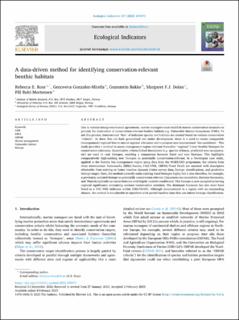A data-driven method for identifying conservation-relevant benthic habitats
Peer reviewed, Journal article
Published version
Permanent lenke
https://hdl.handle.net/11250/3091757Utgivelsesdato
2023Metadata
Vis full innførselSamlinger
- Articles [3009]
- Publikasjoner fra CRIStin [3056]
Sammendrag
Due to various intergovernmental agreements, marine managers must establish marine conservation measures to prevent the destruction of conservation-relevant benthic habitats e.g. Vulnerable Marine Ecosystems (VME). To aid this process, international “lists” of indicator species and habitats are created based on various conservation “criteria”. As these lists are both generalised and under development, there is a need to create comparable (management) regional lists to ensure regional relevance and to propose new international “list candidates”. This study provides a method to assess management region relevant (hereafter “regional”)/new benthic biotopes for conservation-relevance. Quantitative criteria-linked descriptors (e.g. species richness, predicted area occupancy, etc) are used to rank biotopes, enabling a comparison between listed and new biotopes. This highlights comparatively high-ranking new biotopes as potentially conservation-relevant. In a Norwegian case study, applied to the Barents Sea management region using data from the MAREANO programme, the criteria from three international frameworks (EBSA/Azores, FAO/VME, OSPAR/Texel Faial) are assessed with descriptors obtainable from existing or future baseline datasets (video survey data, biotope classifications, and predictive biotope maps). Here, the method correctly ranks existing listed biotopes highly but it also identifies, for example, a previously unlisted biotope as potentially conservation relevant (Cucumaria sea cucumbers, Eucratea bryozoans, and Thuiaria hydroids on coarse bottoms with highly variable conditions). This biotope is now accepted as having regional significance warranting national conservation attention. The dominant bryozoan has also since been listed as a FAO VME indicator within ICES/NEAFC. Although demonstrated in a region with an outstanding dataset, the method is transferable to anywhere with partial baseline data that can inform biotope classification.
